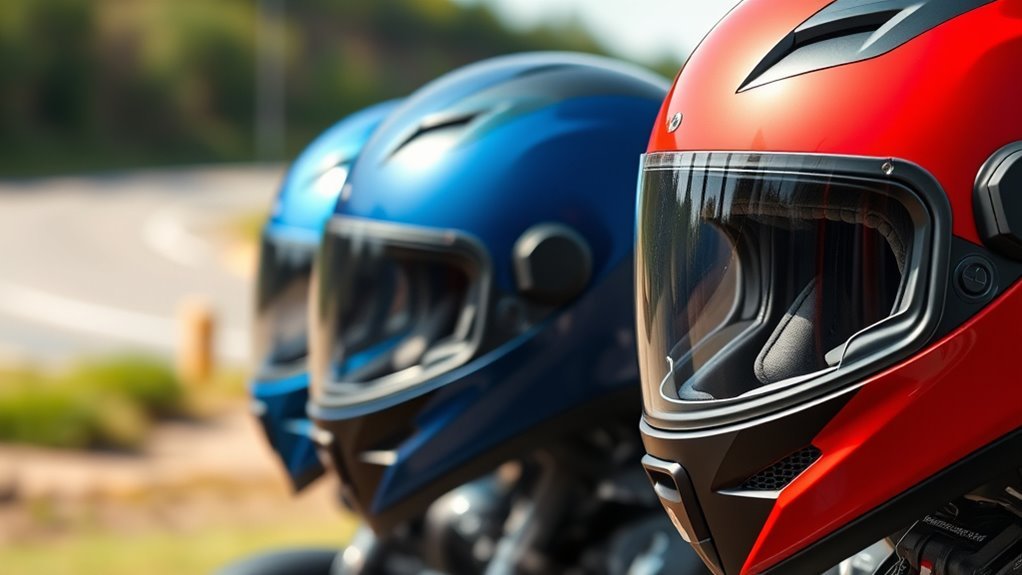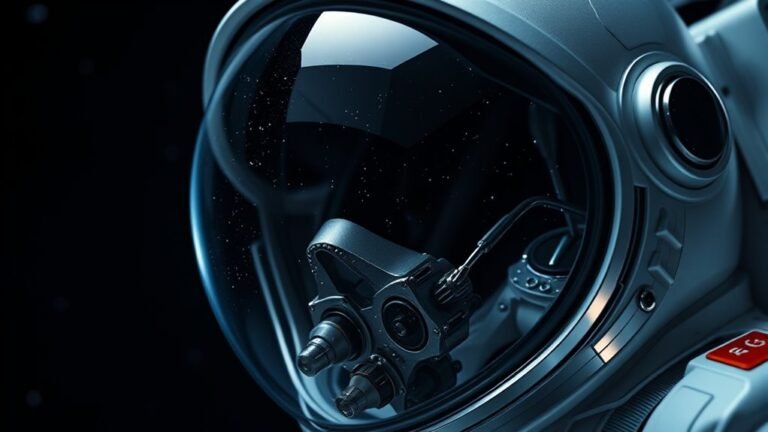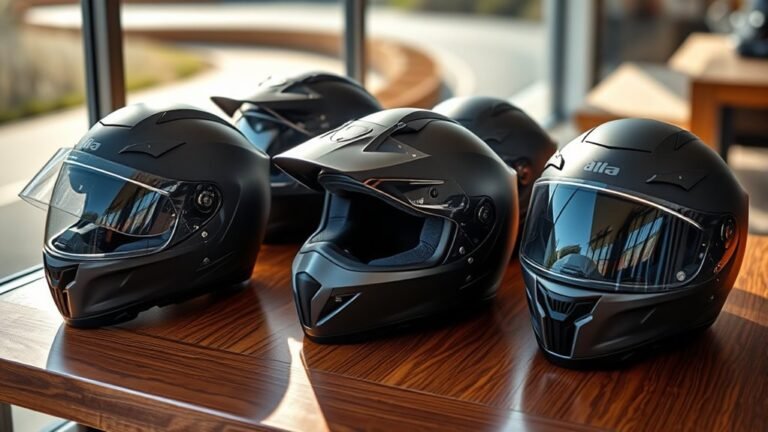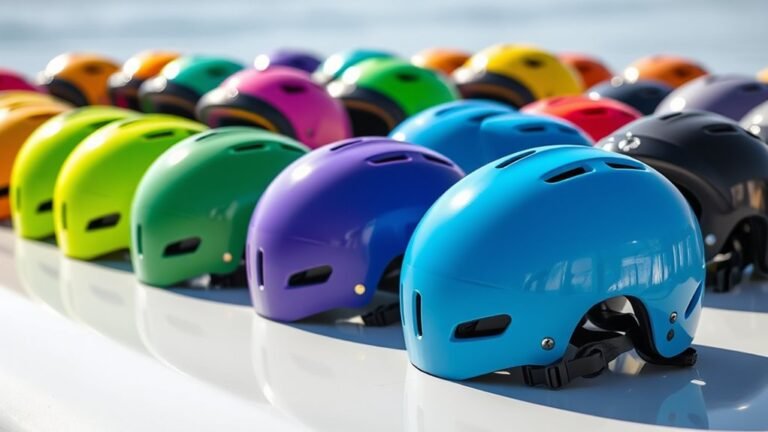Top-Rated Motorcycle Helmets for Long-Distance Riding
When choosing top-rated motorcycle helmets for long-distance riding, focus on safety, comfort, and features that enhance your experience. Look for full-face and modular designs with DOT or Snell certification for impact protection. Prioritize comfort with adjustable padding, ventilation systems, and noise reduction features. Lightweight options improve fatigue, while eyewear compatibility guarantees convenience. Investing in a quality helmet is essential for safety and enjoyment. Explore more insights to make an informed decision.
Importance of Choosing the Right Helmet for Long Rides
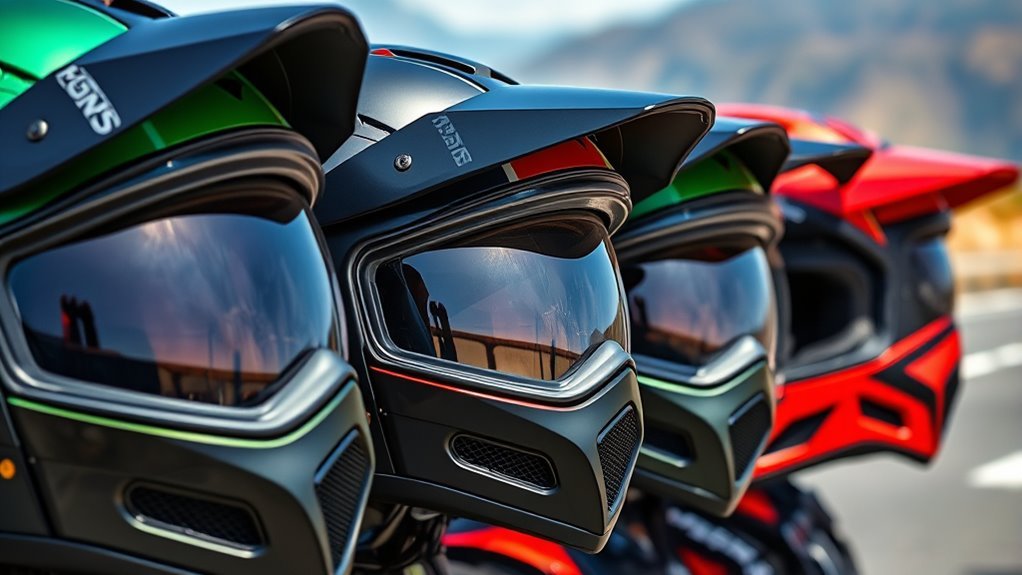
When you’re planning a long-distance ride, choosing the right helmet isn’t just a matter of style; it’s essential for your safety and comfort. Understanding safety standards is important, as they guarantee that the helmet you select meets specific performance criteria for impact resistance and retention. There are various helmet types to take into account, including full-face, modular, and open-face, each offering different levels of protection and comfort. A full-face helmet, for instance, provides extensive coverage, while an open-face helmet allows for better ventilation but sacrifices some protection. Evaluating your riding style and environment will help you determine the best fit for your needs. Prioritizing safety while enjoying the freedom of the open road is critical for a successful long-distance adventure.
Key Features to Look for in Long-Distance Helmets
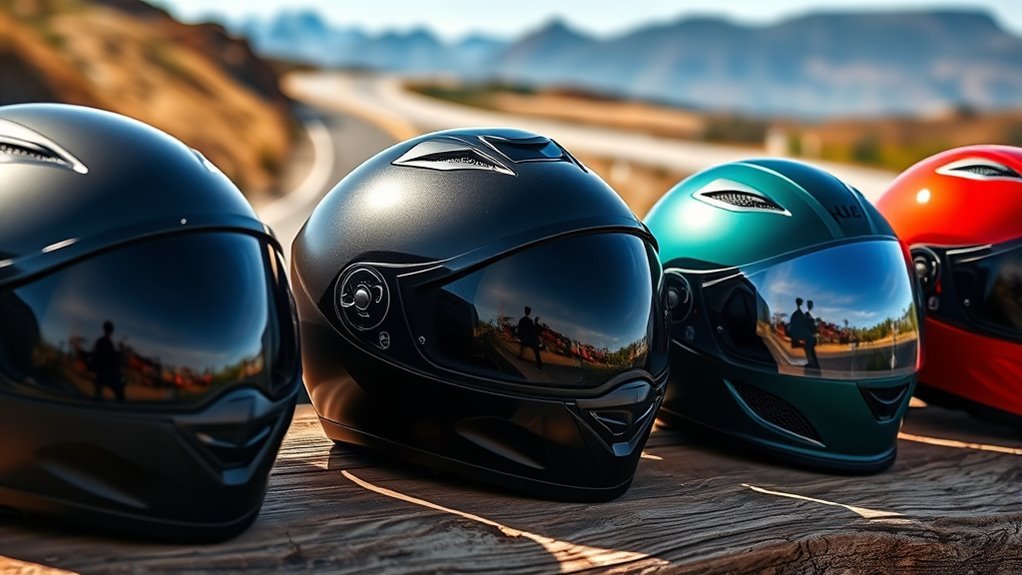
When selecting a helmet for long-distance rides, comfort and fit are essential to prevent fatigue. Additionally, effective ventilation and noise reduction features can greatly enhance your riding experience by keeping you cool and minimizing distractions. Understanding these key aspects will help you choose a helmet that meets your needs for extended journeys.
Comfort and Fit
A comfortable and well-fitting helmet is essential for long-distance riding, as it directly impacts your overall experience on the road. When choosing a helmet, pay attention to padding adjustments that allow for a personalized fit, guaranteeing it conforms snugly to your head shape. A helmet that’s too loose can lead to discomfort and distractions, while one that’s too tight can cause pain during long rides. Consider models with removable and washable liners, which can enhance comfort over time. Look for options that offer various sizes and shapes, accommodating different head shapes to guarantee you find the perfect match. Ultimately, a well-fitted helmet helps you focus on the journey ahead, allowing you to enjoy the freedom of the open road.
Ventilation and Noise Reduction
Ventilation and noise reduction are critical factors to take into account for long-distance motorcycle helmets, as they can greatly influence your riding experience. Look for helmets equipped with adjustable vents that allow you to customize airflow based on weather conditions. Proper ventilation helps maintain comfort, reducing fatigue during long rides. Additionally, effective sound insulation is essential to minimize wind and road noise, enabling you to enjoy the journey without distractions. A helmet with good noise reduction will not only enhance your comfort but will also protect your hearing over time. By prioritizing these features, you’ll guarantee that your long-distance rides remain enjoyable and free, allowing you to focus on the open road ahead.
Best Full-Face Helmets for Long-Distance Riding
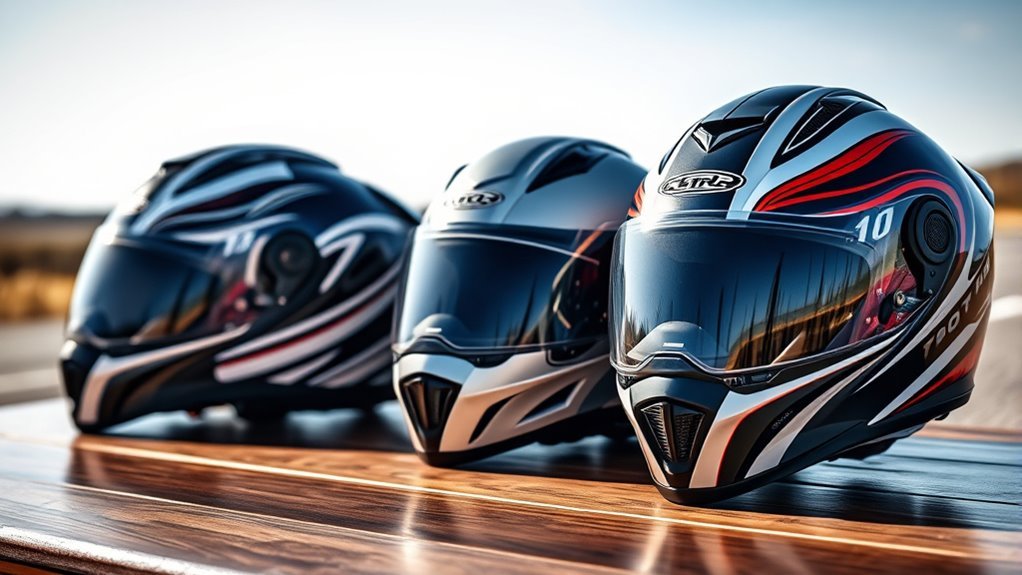
Choosing the right full-face helmet for long-distance riding is essential, as it directly impacts your comfort and safety on extended journeys. Full-face helmets offer significant advantages, like enhanced protection against wind, debris, and impacts. Their design provides a snug fit, reducing noise and improving aerodynamics, making long rides more enjoyable. When selecting a helmet, pay attention to safety ratings; look for options certified by DOT or Snell, ensuring they meet rigorous safety standards. Brands like Shoei and Arai offer top-rated models known for their comfort, durability, and advanced features. Investing in a high-quality full-face helmet not only prioritizes your safety but also enhances your riding experience, allowing you the freedom to explore the open road with confidence.
Top Modular Helmets for Versatility and Comfort
While full-face helmets are favored for their protection, modular helmets offer a unique blend of versatility and comfort that can greatly enhance your riding experience. The modular benefits include the ability to flip up the front, allowing for easy communication and airflow without removing the helmet. This adaptability is particularly valuable during long rides when you need to stop for quick breaks or catch some fresh air. Many modular helmets also feature advanced ventilation systems and removable liners, ensuring you stay comfortable over extended distances. Additionally, they often come with integrated sun visors, enhancing your visibility while maintaining a sleek design. Ultimately, modular helmets provide the freedom to customize your riding experience, catering to both comfort and practical needs on the road.
Lightweight Options for Extended Comfort
When you’re riding long distances, the weight of your helmet can greatly impact your comfort. Modern lightweight helmets utilize advanced materials and aerodynamic designs to reduce drag while enhancing stability at higher speeds. Understanding these innovations can help you choose a helmet that minimizes fatigue and maximizes your riding experience.
Aerodynamic Design Benefits
Although many riders prioritize safety and comfort, the aerodynamic design of a motorcycle helmet greatly enhances long-distance riding experiences. A well-designed helmet provides significant aerodynamic benefits by reducing drag and improving airflow, allowing you to slice through the wind effortlessly. This design leads to better helmet stability at high speeds, minimizing head movement and fatigue. With reduced turbulence, you’ll find that your energy is conserved, making those long rides more enjoyable. Lightweight options further complement this design, preventing neck strain and ensuring comfort over extended periods. By choosing a helmet with superior aerodynamic characteristics, you’re investing in a smoother, more liberating ride, empowering you to embrace the open road with confidence and ease.
Material Technology Advancements
As advancements in material technology continue to evolve, you now have access to lightweight helmet options that greatly enhance comfort during long-distance rides. Helmets made from carbon fiber are leading the charge, providing exceptional strength without the added weight. This innovative material not only reduces fatigue but also offers superior impact resistance, ensuring your safety on the road. Unlike traditional materials, carbon fiber molds seamlessly to the contours of your head, providing a snug fit that minimizes wind resistance. This lightweight design allows you to ride for hours without discomfort, giving you the freedom to explore the open road. Investing in a carbon fiber helmet means prioritizing both comfort and safety, vital elements for an unforgettable long-distance riding experience.
Helmets With Advanced Ventilation Systems
While long-distance riding can be exhilarating, it often comes with the challenge of maintaining comfort during extended hours on the road. Helmets equipped with advanced ventilation systems are designed to tackle this issue head-on. These helmets optimize airflow efficiency, allowing for a continuous flow of fresh air while minimizing heat buildup inside the helmet. Look for models featuring multiple intake and exhaust vents, which enhance heat management by allowing hot air to escape while drawing in cooler air. This not only keeps you comfortable but also prevents fatigue, enabling you to enjoy the ride without distractions. Investing in a helmet with superior ventilation can greatly elevate your long-distance experience, giving you the freedom to ride longer and more comfortably.
Noise Reduction Features in Long-Distance Helmets
When you’re starting on a long-distance ride, the last thing you want is the constant drone of wind and road noise distracting you from the journey ahead. That’s where noise reduction features come into play. Look for helmets equipped with active noise-canceling technology, which actively combats external sounds, allowing you to focus on the open road. Additionally, sound isolation materials are essential; they absorb and block noise, enhancing your riding experience. A well-designed helmet shell can minimize turbulence, further reducing wind noise. Investing in a helmet with these features means you can enjoy the freedom of the ride without the irritating distractions that can wear you down over long distances. Prioritize comfort and clarity for a truly liberating experience.
Best Helmets for Eyewear Compatibility
When choosing a helmet for long-distance riding, eyewear compatibility is essential for comfort and safety. You’ll want to contemplate designs that accommodate various lens types without compromising fit or protection. Understanding the specific compatibility features of different helmets can help you make an informed decision that enhances your riding experience.
Eyewear-Friendly Helmet Designs
Have you ever struggled to find a motorcycle helmet that accommodates your eyewear comfortably? Eyewear-friendly helmet designs focus on seamless eyewear integration, letting you ride freely without discomfort. These helmets often feature spacious interiors and adjustable padding, allowing for various lens options and ensuring a snug fit for your glasses.
Here’s a table showcasing some top eyewear-compatible helmets:
| Helmet Model | Features | Price Range |
|---|---|---|
| Arai XD4 | Spacious interior | $600 – $700 |
| Shoei GT-Air II | Eyewear-friendly design | $500 – $600 |
| Bell Qualifier DLX | Adjustable cheek pads | $200 – $300 |
| HJC RPHA 11 | Great ventilation | $400 – $500 |
Choosing the right helmet can elevate your long-distance riding experience.
Lens Compatibility Considerations
Selecting a helmet that not only fits well but also accommodates your eyewear is essential for long-distance riding comfort. When choosing a helmet, consider the lens types you use, such as prescription glasses, sunglasses, or goggles. Some helmets feature special cutouts or larger eye ports designed to minimize discomfort and pressure on your frames. Additionally, pay attention to lens coatings; anti-fog and scratch-resistant options can enhance your riding experience. Helmets with removable visors or face shields can also provide flexibility, allowing you to accommodate different eyewear styles. Ultimately, ensuring compatibility between your helmet and eyewear can greatly impact your long-distance adventures, allowing you to ride freely and confidently without distractions or discomfort.
Stylish Designs That Don’T Compromise Safety
Finding the right motorcycle helmet for long-distance riding doesn’t have to mean sacrificing style for safety. Many modern helmets combine robust safety features with stylish graphics and modern aesthetics, allowing you to express your individuality while staying protected. Look for options that meet safety certifications without compromising design; a well-ventilated shell can enhance comfort during long rides. Brands now offer helmets with sleek lines and vibrant colors, ensuring you don’t just blend in. Additionally, removable liners with trendy designs can make maintenance easier while allowing for personalization. By choosing a helmet that marries safety and style, you can confidently hit the open road, enjoying the freedom of the ride without compromising on protection or appearance.
Maintenance Tips for Long-Distance Riding Helmets
Although long-distance riding can be exhilarating, proper maintenance of your helmet is essential for ensuring its longevity and effectiveness. Here are some key maintenance tips:
- Regular Cleaning Techniques: Use a mild soap and water to clean the exterior and interior padding. Avoid harsh chemicals that can damage the materials.
- Inspect for Damage: Regularly check for cracks or wear in the shell and visor. Any signs of damage can compromise safety, so replace the helmet if necessary.
- Smart Storage Solutions: When not in use, store your helmet in a cool, dry place away from direct sunlight. A helmet bag or a dedicated shelf can help maintain its shape and protect it from dust and scratches.
Frequently Asked Questions
How Do I Properly Fit a Motorcycle Helmet?
To properly fit a motorcycle helmet, you should start with helmet sizing. Measure your head’s circumference just above your eyebrows, then consult the manufacturer’s sizing chart. The helmet should sit snugly without pressure points, and you shouldn’t feel it shift during movement. Verify that it meets safety standards for maximum protection. Adjust the chin strap for a secure fit, allowing only a finger’s width between the strap and your chin for comfort and safety.
What Is the Lifespan of a Motorcycle Helmet?
A motorcycle helmet typically has a lifespan of about five to seven years, depending on helmet materials and usage. Over time, exposure to elements can degrade the materials, compromising safety standards. Even if a helmet looks fine externally, the internal foam may lose its protective capabilities. Regularly check for any signs of wear or damage, and always replace your helmet after a significant impact to guarantee you’re fully protected on your ride.
Can I Customize My Helmet’s Interior?
Yes, you can customize your helmet’s interior! For example, if you ride long distances like Jake, he replaced his helmet liners and added thicker interior padding for extra comfort. Many brands offer removable and adjustable liners, allowing you to tailor the fit to your head shape. This customization not only enhances comfort but also improves safety by ensuring a snug fit, which is important during those long rides where freedom on the road is essential.
Are There Specific Helmets for Different Riding Styles?
Yes, there are specific helmet styles tailored to various riding preferences. For instance, full-face helmets provide maximum protection for sport riders, while open-face designs offer freedom and airflow for cruisers. Adventure and dual-sport helmets bridge the gap between on-road and off-road riding, accommodating diverse terrains. It’s essential to choose a helmet that aligns with your riding style, ensuring both safety and comfort while you enjoy the open road.
How Often Should I Replace My Motorcycle Helmet?
How often should you replace your motorcycle helmet? Think about this: your safety’s worth the investment. Helmet replacement frequency typically suggests every five years, but if you’ve had a crash, it’s essential to replace it immediately. Additionally, stay updated on safety standards updates, as materials and technology improve over time. Remember, your helmet’s not just gear; it’s your first line of defense on the road, ensuring your freedom and safety while riding.
